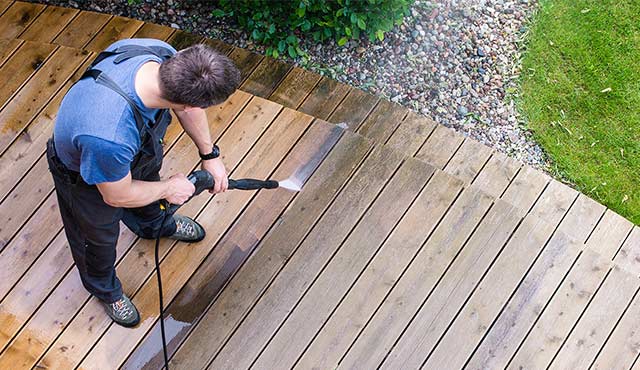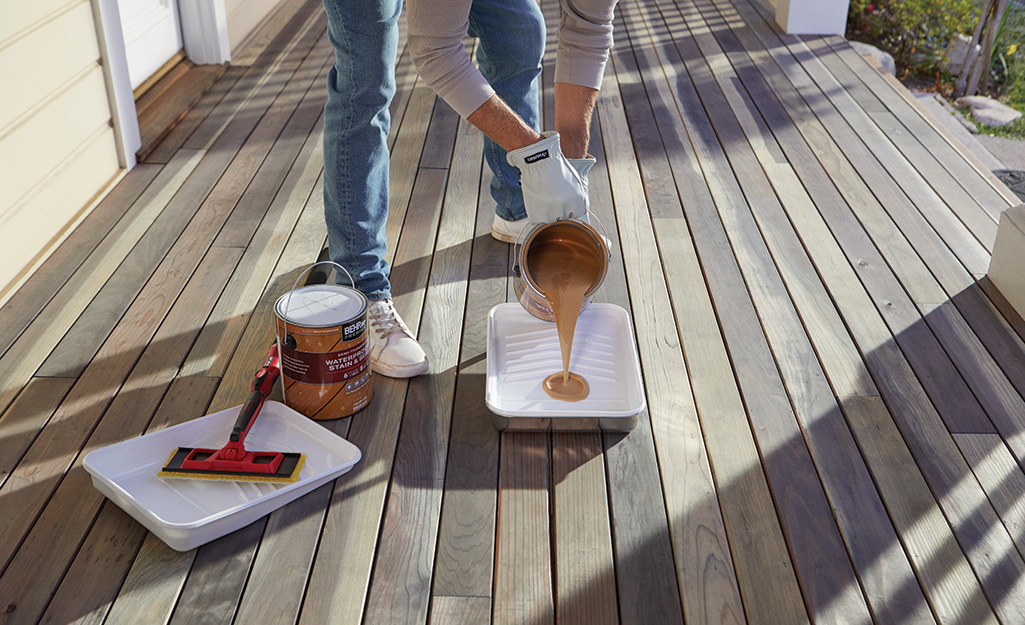A Comprehensive Guide to Various Types of Deck Staining Techniques for Ultimate Protection and Looks
In the world of deck maintenance, the art of staining stands as a critical step towards both protecting the stability of your exterior space and enhancing its aesthetic charm. As we browse with the complex globe of deck discoloration techniques, one begins to value the nuanced techniques that can make all the distinction in between an average surface and a remarkable one. From the selection of the appropriate tarnish type to the thorough application approaches, each element plays an important function in achieving that perfect equilibrium in between protection and visual appeals. Join us as we uncover the secrets behind attaining the utmost deck staining results-- a journey where every brushstroke forms not just the surface, yet the really essence of your outdoor refuge.
Understanding Various Sorts Of Spots
Numerous kinds of stains are frequently made use of in the process of deck discoloration to attain various visual and safety results. On the various other hand, semi-transparent discolorations use a balance between shade enhancement and protection, permitting some timber grain to reveal through.
Toners include a tip of shade to the wood while offering minimal protection, making them suitable for more recent decks with much less wear. Comprehending the attributes and benefits of each type of stain is crucial for attaining the preferred look and resilience for your deck.
Choosing the Right Discoloration Shade
When thinking about the appearances of your deck discoloration job, the choice of tarnish shade plays a vital function in enhancing the safety high qualities of the selected tarnish type (Water-Based Stains). The color you choose can dramatically affect the general appearance of your deck, along with its capability to withstand the components in time
When selecting a discolor color, it's important to consider the existing color plan of your home's exterior. Balancing the deck tarnish with the total visual of your residential property can produce a natural and visually enticing exterior room. Furthermore, the shade of your deck stain can affect the temperature of the deck surface; darker shades tend to absorb even more warmth, while lighter colors mirror sunlight and stay cooler.
Moreover, the sort of wood you are discoloring will certainly also impact how the discolor shade shows up. Different wood types can interact with the stain in different means, potentially changing the last shade. It's recommended to check the tarnish on a small, unnoticeable location of the deck to make certain the color ends up as wanted prior to proceeding with the entire job.
Preparing Your Deck for Discoloration
To ensure a successful and durable deck staining job, thorough preparation of the deck surface is necessary. Begin by cleaning the deck thoroughly to eliminate dust, crud, mold, check and any old complete or discolor. Make use of a deck cleaner or a mix of water and detergent together with a tight brush or stress washer to scrub the surface clean. After cleaning, enable the deck to dry totally prior to going on to the following action.
Examine the deck for any damaged or rotten boards that require to be changed. Hammer down any type of sticking out nails and sand any kind of rough locations to ensure a smooth surface for staining. Examine for any loosened barriers or steps that might require tightening up or fixing.
Once the deck is tidy, completely dry, and in great fixing, consider applying a timber brightener to recover the deck's natural shade and open up the timber pores for better tarnish penetration. Ultimately, safeguard any kind of close-by plants, furniture, or surface areas with plastic sheet prior to waging the discoloration process. Proper prep work is key to accomplishing a professional-looking coating and maximizing the durability of your deck tarnish.
Applying Discoloration With Various Methods
For a flawless and expert finish, the technique of using stain plays a critical role in improving the look and resilience of your deck. There are a number of strategies you can utilize to make sure a reliable application of stain.
It is perfect for complex locations and getting to between deck boards. Back-brushing after rolling is suggested to even out the stain and work it into the wood for better penetration.
Splashing is one more popular strategy, supplying rate and ease of application, specifically for huge deck areas. Whichever technique you pick, making certain appropriate preparation and adhering to supplier guidelines will help achieve a beautiful and durable tarnish coating on your deck.

Preserving and Re-staining Your Deck
When it comes to re-staining your deck, the frequency depends on numerous variables such as the kind of discolor made use of, the environment in your location, and how much wear and tear your deck experiences. Generally, it is recommended to re-stain your deck every 2-4 years to keep its defense and looks.
Prior to re-staining, ensure the deck is clean, completely visit here dry, and cost-free of any previous stain residue. Fining sand may be essential to smooth out harsh locations or remove old tarnish that is flaking. Choose a high-quality discolor that matches your deck's material and supplies the desired level of defense. Use the discolor uniformly using the proper strategy talked about previously in this overview to guarantee a beautiful and resilient coating - Chicago Deck Staining. By staying aggressive with maintenance and re-staining, you can take pleasure in a well-protected and visually enticing deck for years ahead.
Verdict
Finally, comprehending the various kinds of deck discolorations, choosing the best color, appropriately preparing the deck, using discolor with numerous methods, and keeping and re-staining the deck Bonuses are crucial actions for best defense and aesthetics. By following these steps, you can guarantee that your deck remains in top condition for many years ahead.
Additionally, the color of your deck stain can affect the temperature level of the deck surface area; darker shades often tend to take in more warm, while lighter colors reflect sunshine and remain cooler.
It's a good idea to check the discolor on a little, unnoticeable area of the deck to ensure the shade transforms out as desired before proceeding with the entire project.
